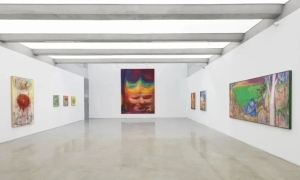文/杨小彦
折磨邓箭今艺术生涯的,我想不仅仅是出于一种对绘画的理解,更是出于一种无法回避的本能。在他十几年的绘画实践当中,他经历了几次较大的变化。从以自我为中心形象到把自己包裹其间的群体偶像,从城市无聊而乏味的组合到悬浮状态的极端表现,都体现了邓箭今本人的困惑和对生存的个人透视。他固执地通过一系列的画幅不断地表达其内在的深刻感受,那就是对生活的感性体验:一种既无奈又感激的矛盾心理。无奈是因为生命本身的有限与局限,使生命的张扬常常受到了无缘无故的压抑。结果是,邓箭今始终不渝地将过好每一天视作人生的第一要事。问题是,我们总是有诸多的错误使得每一天往往并不总是那么如意。感激则是通过每一天具体而微的生活细节来充实自己,并告诫自己不要坠入无法自拔的衰伤当中。然而,之所以我们还需要不断地告诫自己不要对生活本身充满怨恨,是因为生活本身一定存在着不如意的细节让我们难以忘怀。结果,感激本身就必然包含了善意的自欺欺人,包含了让部分记忆丧失掉的麻木。这样一来,无奈与感激就转化为性与情的对立了。从性出发,我们可以不管现实的局限,因为性是本能的,是超出了现实的规范和约束的,因而是不现实的,幻想的和不切实际的;而情则是一种温和的话语方式,微笑着面对生活中的一切,切入实际又不失浪漫情怀。甚至,性是粗暴的,不讲道理的,直来直去的;而情则受到现实的约制,有着明确的针对性。邓箭今就是这样,日复一日地生活在性与情之间,而所有关于这个话题的表达,都毫无保留地放在了他的绘画中,并造成了他的绘画前后风格的巨大变迁。当我们注意到他的自我形象阶段时,我总觉得我看到了一个自恋而自信的艺术家形象;当我看到画家画群体偶像时,我意识到画家的眼光被自己与周围的人的关系感到了困惑。当画家在画面中极力表达一种视觉上的无聊感时,他更多地是以一种冷眼的姿态介入现实生活;相反,当他在自己的形象上发现了个人世界被侵害的悲剧时,他就真的在画面中揉杂了一种类似歌吟的情怀,如歌如诉,如吟如语,既自言自语又要固执地告诉来者。无疑,这是一种复杂的情怀,就象我在一篇关于邓箭今的文章中所说过的那样,有两个邓箭今的存在:
这一个邓箭今是一个有着自恋倾向的人,他把自己作为“他者”,同时又作为“在场”的“主体”,深切地表达了处身在私人空间与公共空间之间的狭窄地域的窘况。而另一个邓箭今则是面对青春的诉说者,他内心的生命力促使他一而再再而三地去回顾青春期的各种情态,并把青春作为真实的对象而不是主体,不断地呈现在画面上。结果邓箭今的描绘风格发生了微妙的变化,从具像的表现有节制地转向象征主义;或者说,在他的象征的符号系统中,仍然用表现的手法来进行创作。这表明了画家对潜藏在人生勃发期的非理性力量有着一种迷惑与向往,而这种迷惑与向往却又有如某种梦幻一样纠缠着画家,使他无法摆脱。(见《穿越梦幻的青春话语 》)
我想我当时的意思是指在邓箭今的艺术中存在着一种分裂,这种分裂与他的人生态度密切相关。在他以自我为主题的阶段,他敏感的问题总是如何去获取一个完整的属于个人的真实空间,所以,在那个时期,画家所关心的总是怎么样才能“拒绝侵犯”(可以说画家是反反复复地用了各种形象和动作来表现这个或明或暗的主题的)。而当他走出个人空间时,城市生活又成为他眼中的一个集体偶像而存在,成为一个与他发生着暧昧关系的外部世界。既然是偶像,那么他就只能用一种似是而非的形象来指称其中的内涵。于是,邓箭今的画面就出现了一种少有的麻木与疯狂的奇妙结合:所有人都在笑,但却不知为了什么?画家总是坐在这些笑着的人群中,但却与他们没有什么紧密的关系。然后,不知出于何故,画家开始对悬浮的状态产生兴趣,他画面中的人物渐渐地都晃动起来,在空中作各种各样的动作。于是,我从中觉察到了一种信号,一种存在于画家心理上的张力,有时这种张力相当松驰,有时却又崩得很紧很紧,仿佛稍不留意就会断了一样。然后,一发而不可收拾,画家一下子走进了一个完全由女性符号组成的世界。他从情无可挽回地坠入到了性的深渊,同时,又不断地仔细而坚决地审察这个世界的让人心醉神迷的细节。在这个世界里,女性成为了一种象征,一种作态的表现,一种扭曲和张扬的集合。她们在呻吟,在歌唱,在欢乐,在骚首弄姿,在无情地迫视着你的存在,同时又无视你的存在。画家在他创造的世界中开始无法自制地挣扎起来了。他在一种彻底的性的渲泻中感悟到了前所未有的情的本质。他越来越觉得他在自己的世界中浸淫得太过久远了,以致于把这个本来属于画家所创作出来的境界往祭坛上送。于是,从一个一个扭动的女人体开始,最后画家对仪式产生不同寻常的认识。我们先是在《春光无限》看到了女人体解体,接着这种解体变成了连续的两张《守夜人》、《有血有肉的东西NO.2》中的抽象(我可不把画家这两张作品读解抽象,而宁愿继续看成是解体的发展),最后,画家定格在了《有血有肉的东西NO.3》上了。他意识到了性与情当中的色与空的相关主题了,意识到了“色即是空空即是色”这么一个古老的佛教命题。画家似乎有些大彻大悟了,他用了十几年的时间,从寻求画家个人真实空间开始,到对城市群体偶像的迷茫与隔阂,再到对自我存在的质疑(悬浮状态的写照),再到质疑一个性的世界,然后又从这个世界准备出走(我怀疑画家的画面不断增加的抽象意味和祭坛象征,恰恰预示着画家下一步的出走)。问题是,画家准备走到哪里去呢?这是一个
既是画家留给观众,同时也是留给自己的重大问题。
1998年
Deng Jianjin--- Live Between Sentiment and Sex
By Yang Xiaoyan
What torturing Deng Jianjin’s art career, I think, is not only from the understanding of painting but also from an unavoidable instinct. In his painting practice for more than a decade, he has experienced several large changes. From the self-centered image to the group image having himself in, from the bored combination of city to the extreme state of suspension, all of them express Deng Jianjin’s confusion and individual perspective to life. Through series of pictures, he stubbornly and continuously expresses his inside deep feeling, the emotional experience of life: a ambivalent feeling both helpless and grateful. Helplessness is due the limit and restriction of life itself oppressing the activity of life without reason. As a result, Deng Jianjin insistently takes spending everyday well as the most important thing of life. The problem is that we have too many mistakes that make everyday not so satisfying. Gratitude is to fill them with concrete life details and tell the selves don’t fall in the inextricable sadness. However, the reason we have to constantly remind ourselves not to resent life itself is that life itself has unsatisfying details we cannot forget. As a result, gratitude itself contains self-deception for goodwill and numbness causing the loss of some memories. As a result, helplessness and gratitude become opposite to sentiment and sex. Starting from the point of sex, we can be regardless of the limitation of reality, because sex is intrinsic and beyond the norm and constraint of reality therefore it’s unrealistic, impractical and fantasy. While sentiment is a kind of moderate discourse, facing everything in life with smile, real but no lack of romance. And even sex is brutal, unreasonable and straight while sentiment is restricted by reality with a clear target. Deng Jianjin is like that living between sex and sentiment day after day. All of the expressions about this topic unreservedly remain in his paintings, resulting in the huge change of his painting style. When we take note of the period of his self-image, I always feel I see an artist image which is narcissistic and self-confident. When I see the painting of group images, I feel his relation with the people around confuses the painter. When the painter tries hard to express a sense of boredom on vision, he is more involved in the real life with a cold attitude. On the contrary, when he finds the tragedy of the invasion of individual world on his image, he mixes a song-like feeling in his picture, like soliloquy but also stubbornly telling something to the comers. Undoubtedly, it’s a complicated sentiment just like I mentioned in another article on Deng Jianjing that there are two Deng Jianjin existing:
This Deng Jianjin is a person with narcissistic tendency. He takes himself as “the other”, meanwhile as the “present” “subjectivity”, deeply expressing the predicament of the narrow space he locates in between private space and public space. The other Deng Jianjin is a teller in the face of youth. His inner vitality pushes him to retrospect the various modals of his adolescence, take youth as real object but not subjectivity and continuously present on the screen. As a result, Deng Jianjin’s painting style got subtle changes turning the figurative into symbolism. In other words, in his symbol system he still uses representative methods. It exposes the painter’s longing and confusion to the irrational force hidden in the growing period of life. The confusion and longing like dreams entangle the artist so that he could not shake off. (See Adolescent Words Going Through Dream)
I think what I mean at that time is towards a split that exists in Deng Jianjin’s art. This split is totally related to his attitude towards life. In his period taking the self as theme, he is always sensitive to the issue of how to obtain a completely individual and real space. Therefore, in that stage, what the painter mostly concerned is how to “refuse violation”. (It can be said that the painter repeatedly express the open or secret theme by various images and actions.) When he goes out of the personal space, urban life becomes a collective idol in his eyes, an outside world generating an ambiguous relation with him. Since it’s idol, he can only uses a paradoxical image to locate the connotation inside. As a result, there’s a rare and wonderful combination of numbness and craziness: everybody is laughing but no one knows the reason. The painter is always sitting among the laughing crowd, but doesn’t has close relation with them. Then we don’t know the reason that the artist began to interest in the state of suspension. The figures in his pictures gradually shake up and make various actions in the air. Therefore, I aware of a signal in it, a psychological tension of the artist. Sometimes the tension is relaxed and sometimes it’s so tight that will be cut off by less attention. Afterwards it’s far out of control. The artist enters into a world totally composed by female symbols. He irrevocably falls into the sexual abyss, meanwhile, he continuously, carefully and firmly investigate the ecstatic details of the world. In this world, female become a symbol, an artificial performance, a collection of distortion and publicity. They are moaning, singing, joying, showing and flirting. They are relentlessly and compellingly seeing you, meanwhile ignore your presence. The painter cannot help beginning to struggle in the world he created. He unprecedentedly sensed the nature of sentiment in the thorough vent of sex. He felt more and more that it’s too long that he was immersing in his own world. Therefore, he sent the situation originally created by himself to the altar. As a result, starting from a twisting female body, finally the artist has an unusual understanding of ceremony. First, we see the disintegration of female body in Unlimited Spring. Then the disintegration turns into two continuous pieces of Night Watchman and The Things with Flesh and Blood No.2 (I don’t understand these two pieces as abstract. I would rather to understand them as the continuous development of the body disintegration.) Finally, the painter froze the frame in The Things with Flesh and Blood No.3. He is aware of the themes of color and emptiness associated with sex and sentiment. He is aware of the ancient Buddhist proposition, “color is empty and emptiness is color”. The painter seems totally enlightened. He has used several decades starting from finding the real personal space, to the confusion and gap to the urban group idol, and to the question to the self-existence (the portrayal of the state of suspension), and to the question to a world of sex, then preparing to run away from this world ( I suspect the abstract sense and the symbol of altar ever-increasing in his paintings indicate that the next step of the artist). The problem is where the artist plans to go. The artist left this crucial question both to his audiences and to himself.
1998






















